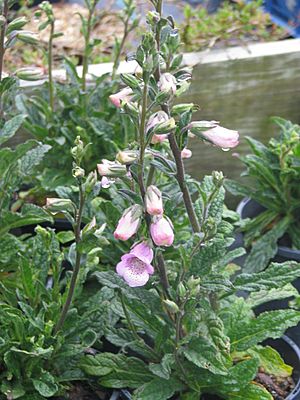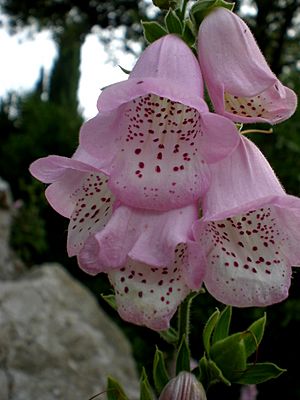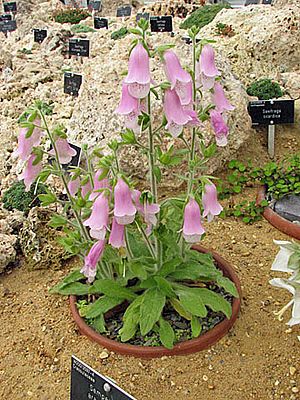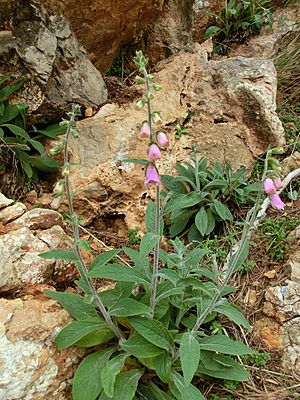Digitalis minor facts for kids
Quick facts for kids Digitalis minor |
|
|---|---|
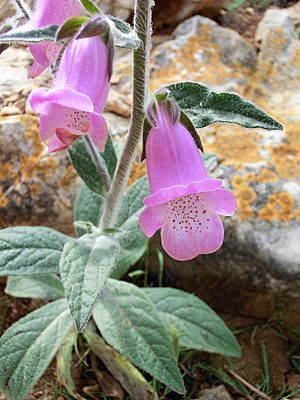 |
|
| Digitalis minor showing flowers and foliage in situ on Mallorca's Formentor peninsula. | |
| Scientific classification | |
| Genus: |
Digitalis
|
| Species: |
minor
|
| Synonyms | |
|
|
Digitalis minor is a type of flowering plant in the Plantaginaceae family. It is also known as the dwarf Spanish foxglove. This plant grows for two years (it's a biennial) or lives for a short time as a perennial. It is a type of foxglove that grows only in the Balearic islands. It has large, hanging, pink or purple flowers.
Digitalis minor is very similar to the common purple foxglove. You can best tell them apart by their small fruits. It is one of the few foxgloves that can grow in alkaline soils, which are soils with lots of lime.
In the Catalan language, people call this plant by several local names. These include didalera, didals, didals de la Mare de Déu, boca de llop, and herba de Santa Maria.
Contents
Plant Names: Taxonomy
For a long time, this plant was known as Digitalis dubia. Now, D. dubia is considered a synonym of D. minor. This means it's an older name for the same plant.
The name D. minor is actually older and has priority. This means it should be used if both names describe the same plant. Carl Linnaeus first described a plant as D. minor in 1771. He only wrote that it grew "in Spain." More recently, plant experts around the world have agreed to use Linnaeus's name.
Linnaeus wasn't the first to describe this plant. He got his information from Joseph Pitton de Tournefort's work from 1700. Tournefort called the plant Digitalis Hispanica, purpurea, minor. Tournefort also got his information from even older books by Paolo Boccone (1697) and Jacques Barrelier (1697).
D. dubia was first described by a Spanish botanist named Juan Joaquín Rodríguez y Femenías in 1874. He thought D. minor was a different plant. He said D. dubia had straight leaf veins and longer flower stalks. Its calyx (the green part holding the flower) was oval and rounded.
Different Types: Varieties
This plant can look very different from one individual to another. This is called being polymorphic. Until recently, two main types (varieties) were recognized:
- Digitalis minor var. minor: This type is covered with tiny hairs, like a fuzzy coat.
- Digitalis minor var. palaui: This type is smooth and has no hairs. You can find these hairless plants on both Minorca and Majorca.
In 1914, another variety was described, but its validity was doubted. Later, in 1958, a botanist from Mallorca described two more varieties. These were named after local botanists. One of them, subsp. palaui, had larger, green, hairless leaves.
A genetic study in 2001 looked at many plants from the three islands. It found that the plants grouped into three main populations, one for each island. However, the hairy and hairless types (phenotypes) were not very different genetically on Menorca. On Majorca, the populations could be told apart by where they were collected. The study did not strongly support keeping the two varieties as separate types.
What it Looks Like: Description
This plant is a biennial or a short-lived perennial. It has pink, hanging flowers. Sometimes, you can find rare white-flowered plants. The plants often grow in small clumps with many leaves close to the ground.
The whole plant is usually covered in soft, woolly hairs. But sometimes, you can find plants that are completely smooth and hairless. The base of the plant is woody and can have many branches or just one group of leaves. Each group of leaves sends up a stem that is 10 to 80 centimeters (about 4 to 31 inches) tall. These stems can be green or purplish and are also usually hairy. Most of the leaves grow at the bottom of the plant.
The leaves are usually a grayish-green color. The lower leaves are 3 to 10 cm (1 to 4 inches) long and 1 to 4 cm (0.4 to 1.6 inches) wide. They are oval-shaped, soft, and not leathery. Their edges can be smooth or slightly wavy. The underside of the leaves is very hairy and ash-grey.
The flowers grow in a cluster that is 5 to 25 cm (2 to 10 inches) long. There are usually 5 to 20 flowers in each cluster. Each flower has a stalk that is 4 to 21 mm (0.16 to 0.8 inches) long. The calyx (the green outer part of the flower) has unequal parts. The flower itself is bell-shaped, 28 to 35 mm (1.1 to 1.4 inches) long, and pink to purplish-pink. It is hairy on the outside.
Inside the flower tube, there are dark-purple dots with white circles around them. These white circles often join to form a large white patch. The upper part of the flower's opening can be smooth or split into two. The lower lip of the flower has two ear-shaped side parts that are clearly split down to the opening. The fruit is a capsule that is 10 to 15 mm (0.4 to 0.6 inches) long. It is oval or almost round and much shorter than the calyx. The seeds are small, chestnut brown, and shaped like tiny cylinders.
Similar Plants
In plant guides, D. minor is often compared to Digitalis mariana, D. purpurea, and D. thapsi. If you find a foxglove on the Balearic Islands, it is most likely D. minor. You can tell it apart because its fruit (capsule) is clearly shorter than the calyx. Also, the lower lip of its flower has very developed, ear-shaped side parts that are split down to the opening.
Digitalis thapsi is different because it has very sticky, yellowish hairs. Its leaves in the middle of the plant also grow down the stem.
Digitalis purpurea is very similar to D. minor. The main difference is that D. purpurea has larger fruits.
D. mariana has calyx parts that spread out. Its flower tube also narrows suddenly at the base. Its fruit is the same length or longer than the calyx. The lower lip of its flower has small, rounded side parts that are not ear-shaped or split to the opening. These features help tell it apart from D. minor.
Chromosomes
Scientists have found that Digitalis minor has 56 chromosomes (2n=56). This plant also produces special chemicals called cardenolides.
Where it Grows: Distribution
Digitalis minor is found only in the eastern Balearic Islands. These islands are Majorca, Menorca, and Cabrera.
The Balearic Islands were formed over millions of years by land movements. Sometimes, they were connected to mainland Spain or other islands like Corsica. This geological history helps explain why certain plants, like D. minor, are found on these islands. Scientists believe D. minor came from ancestors of D. purpurea that moved from Spain. This means it's a 'schizoendemic' species, which evolved after being separated from a nearby group of plants.
The genetic studies show that D. minor has never been a very rare plant. There is good genetic diversity within its populations.
Where it Lives: Ecology
In its natural home, Digitalis minor flowers in May and June. Sometimes, it flowers in April or July. Its male flower parts mature before the female parts. This helps with gene flow among different plants.
You can find this plant growing in rocky areas. It lives in cracks in rocks, on cliffs, and in wet rock fissures. It grows in both sunny and shady spots. It also grows on cliffs by the sea. Digitalis minor prefers alkaline soils, which are rich in lime. This is unusual, as most foxgloves do not like these soils. It can grow from sea level up to 1,400 meters (about 4,600 feet) high.
It often grows with other plants that are special to the Balearic Islands. These include Arabis verna, Arum pictum, and Brassica balearicum.
What it's Used For: Uses
Scientists have done experiments with Digitalis minor. They put a gene from another plant, Arabidopsis thaliana, into Digitalis minor. This created new transgenic plants. The goal was to see if these plants could produce more cardiac glycosides. These chemicals are important for making heart medicines. The experiment was successful, and the new plants made more of these useful chemicals.
See also
 In Spanish: Digitalis minor para niños
In Spanish: Digitalis minor para niños


